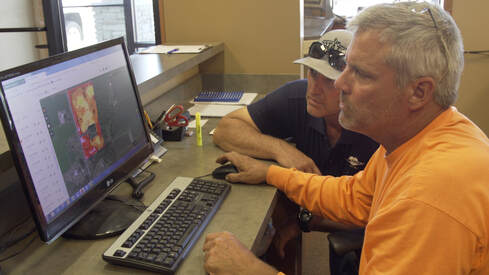 WHATCOM COUNTY, Wash. -- Constant moisture is important to the health and growth of potatoes. Ebe Farms in Whatcom County has tested out several types of irrigation systems to find the most efficient way to keep their potatoes hydrated while conserving water. Greg Ebe, the manager at Ebe Farms, says his family got started in the potato industry in the 1920s. His grandfather was a German immigrant and started the seed potato program in Whatcom County. “We’re blessed with some of the most primed soils in the country, in Whatcom County, for potato production and also a great climate,” Ebe said. “But, we still have to supplement with irrigation, and that’s just critical to us.” Initially, the potatoes were irrigated with handlines, which, Ebe says, requires a lot of labor. And, they are only about 75-80% efficient.They switched to big guns hose reels and unfortunately those are also not very efficient. Big guns reduced labor, but were only about 66% efficient. “We were not making good use of our water,” Ebe said. “Soil and water is everything to us.” They have started to convert a lot of their fields to a drip irrigation system, which is 95% efficient. Mark Goodman with Ebe Farms says that the new systems help replenish the soil. “We are able to maintain a moisture balance throughout the day, a 24 hour period, which is an ideal irrigation technique for a potato crop, which is extremely moisture sensitive,” Goodman says. The new irrigation system is placed right in the root zone, so there is less evaporation. Ebe says the technology is still evolving, but it is continuing to improve. Ebe Farms currently uses satellite feeds to see how their crops are doing. They can see how hydrated the crops are or if they are stressed in any way. Ebe says the technology allows them to monitor how effective the irrigation systems in place are. They can compare the fields day-to-day to see how weather is also impacting the potatoes. “Water is critical to our operation. There’s a lot of competing uses for water. We need to manage it as a finite, precious resource. Drip irrigation makes the most efficient use of the water, rather than waste the water, it leaves it for other uses, such as the salmon habitat. Farming, in general, is the most compatible land use to creating a healthy habitat for salmon recovery.”
0 Comments
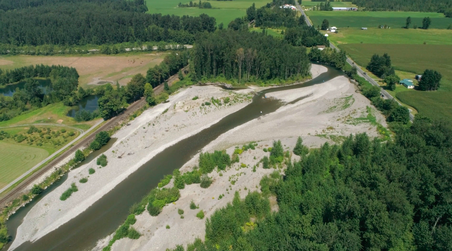 DEMING, Wash. -- New technology is allowing for the waste created on dairy farms to be turned into clean water. Coldstream Farms sits in the south fork valley in Deming, Wash. The valley is narrow and the Nooksack River winds back and forth through the valley. Galen Smith, owner and operator of Coldstream, says it is important that his operation is conscious of the impact his farm has on the environment. “We do have a lot of sensitive areas, that we want to make sure we are protecting water quality, all of those things that are important to farms,” he said. “We want to make sure we are doing a good job.” Two and a half years ago, Smith was contacted by Regenis, a Ferndale company working to help farms with manure management. Eric Powell with Regenis, says the company searched the world for a technology the company believed in. The system separates the manure into three products -- a solid of concentrated nutrients used for fertilizer, concentrated nutrients in the form of a liquid, and clean water that is the result of a reverse-osmosis filtration system. Coldstream received $930,305 in grant money from the Washington State Conservation Commission for the manure management project. They were one of five recipients to get grant money for the use of innovative technology to reduce potential environmental impacts and costs associated with manure management. Coldstream's commitment to sustainability is also evident in their land use strategy, where they work with the Whatcom Land Trust to ensure that the land that they farm along the banks of the South Fork is sustainable and thriving, including 54 acres that they lease from Land Trust. In 2018, Whatcom Land Trust awarded Coldstream the The Bob Keller Memorial Business Conservation Leadership Award. Coldstream is the first clean system installation in Washington of this kind and its use creates 4.3 million gallons of clean water that can go back into the river each year. The Nooksack River is a main route for several types of salmon. The Whatcom Land Trust and the Nooksack Salmon Enhancement Association have spent many hours working on the property to better the area for optimal salmon health. “We were green before being green was cool,” Smith. “We are the ultimate recyclers. We take every drop we get from our cows, and now, we return it to water to a fish bearing stream.” Smith also said their farm needs to operate in a sustainable way that is viable to a dairy operation. “We have to protect not just our farm, but the farming community as we move into the future,” he said.
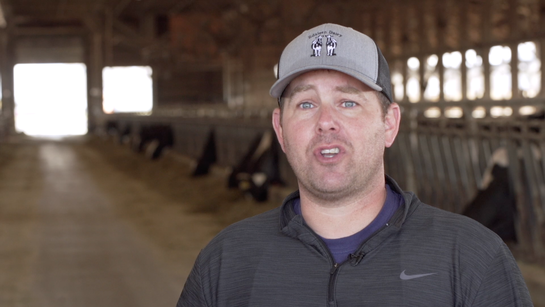 Mitch Moorlag, Edaleen Dairy General Manager and son-in-law of founders Ed and Aileen Brandsma, says as a multi-generational family farm, Edaleen is committed to sustainability. Mitch Moorlag, Edaleen Dairy General Manager and son-in-law of founders Ed and Aileen Brandsma, says as a multi-generational family farm, Edaleen is committed to sustainability. Through all that growth, sustainability remained one of their core values. That’s why, in 2012, Mitch Moorlag, the Brandsma’s son-in-law and general manager of the dairy, made the decision to install an anaerobic digester on the farm. It was a large investment for the farm, but one that they see as worthwhile. “Being willing to take that risk allows us to be sustainable dairy farmers from one generation to the next,” says Mitch. But how does this technology work, and what are the benefits? The manure produced by the cows flows into a large, sealed tank. In that tank, microbes that thrive in areas without oxygen (“anaerobic”) break down the manure, and in the process release biogas, a combination of methane and other gases. That gas is then used to run a generator producing about 544 kilowatts of energy, or enough power for 250 residential homes. The farm also receives carbon credits for this, since the methane that is combusted before it makes it into the atmosphere, where it would otherwise act as a greenhouse gas 28 times more potent than carbon dioxide. The remaining manure is then separated into solid and liquid components. The solids are filtered and used as a soft, fibrous bedding for the cows. The liquids, which have a high concentration of nutrients, are used as an organic fertilizer for the crops that feed the cows. The result is a system that captures and recycles carbon, reduces greenhouse gas emissions, produces carbon-neutral electricity, and allows the farm to more easily manage nutrient levels on their croplands. Puget Sound Energy customers who are interested in using green power like what Edaleen Dairy produces can find more information about the program here.
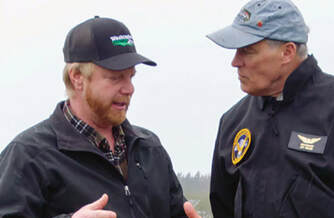 WA Gov. Jay Inslee (right) talks with Whatcom Family Farmers Vice President Rich Appel about the newly-installed fish-friendly floodgate at Appel Family Dairy in April 2018. WA Gov. Jay Inslee (right) talks with Whatcom Family Farmers Vice President Rich Appel about the newly-installed fish-friendly floodgate at Appel Family Dairy in April 2018. For decades, old-style floodgates have kept floodwaters back from thousands of acres of land along the Nooksack by only allowing water from streams to drain into the river, and not back up onto fields when the river runs high, said Frank Corey, Whatcom Conservation District Resource Coordinator. But while those old floodgates helped with high water, the rest of the time they blocked fish from moving upstream into those small tributaries, essentially cutting off important habitat area that the fish need to grow and spawn, Corey explained. New-style “self-regulating” floodgates, including the one installed at Appel Family Dairy, allow fish through, giving them new access to miles of streams where young salmon and other species can thrive and grow large before continuing their journey. They also do a better job of protecting nearby farmland from flooding, creating a win-win for fish and farming, said Corey. He said another benefit of the new floodgates is that it protects small, young fish during floods. When the Nooksack River runs high, the fast water is dangerous for juvenile salmon, and if the river begins to rise, they move to side streams to wait out a possible flood. According to Corey, the self-regulating floodgates allow them to escape the main river before a flood happens, protecting countless smolts from being killed or prematurely swept out to sea. 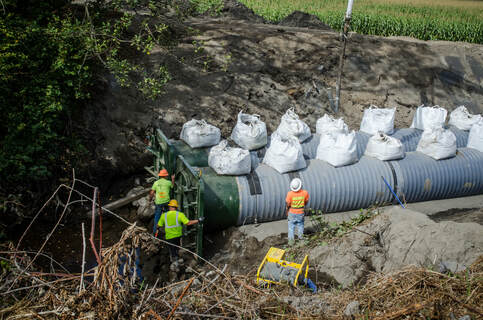 Crews using heavy machinery install the new fish-friendly floodgate at Appel Family Dairy near Ferndale in the fall of 2017. The improved technology creates new access to miles of streams where young salmon and other species can thrive, provides a safe haven for young fish during floods. Crews using heavy machinery install the new fish-friendly floodgate at Appel Family Dairy near Ferndale in the fall of 2017. The improved technology creates new access to miles of streams where young salmon and other species can thrive, provides a safe haven for young fish during floods. These improvements to habitat do come with a cost. Grants from the federal Natural Resources Conservation Service (NRCS), as well as funding from Whatcom County and other agencies and groups helped pay for the new fish-friendly floodgate at Appel Family Dairy. The Appels also allowed access to the area, and contributed a few acres of farmland that the project managers needed to use when the heavy equipment used to build the new floodgate was brought in. But to farmers, the costs and the disruption to their normal operation is worth it. Appel Family Dairy co-owner Rich Appel said it’s incredibly important to them to protect the environment around their farm and in the larger Whatcom County community. “We have been farming here on the banks of the Nooksack River for three generations, and hope to continue for many more,” said Appel. “Taking care of the land, the streams, and the life that lives in them is crucial to our family’s future.”
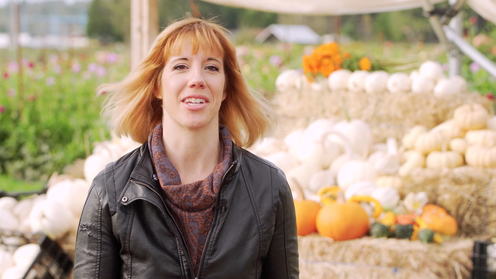 Sara Southerland, Food & Farming Director for Bellingham's Sustainable Connections, talks about small farmers like Triple Wren moving toward more sustainable practices. Sara Southerland, Food & Farming Director for Bellingham's Sustainable Connections, talks about small farmers like Triple Wren moving toward more sustainable practices. In 2012 they founded Triple Wren Farms and began selling cut flowers to local retailers. Their farming success was the result of a combination of lots of hard work and a desire to understand the ecosystems of the Pacific Northwest. After some experiments, they settled on their ideal primary crop: dahlias. The brightly-colored blooms range from two inches in diameter up to a foot, and though they originally come from the mountains of central Mexico, Steve believes their ideal habitat is right here in Whatcom County. “Dahlias like to have really hot days followed by really cold nights, and we have that along with a really long growing season. No other part of the country can grow dahlias as well as we can,” Steve explained. A visit to the farm proves him right: row upon row of dahlias–over 8500 of them–as well as blueberries, pumpkins, and a number of other perennials. Of course, great flowers require great soil conditions, and Steve and Sarah use holistic management practices that promote healthy plants. They use landscape fabric to control weeds and water with ultra-high efficiency drip irrigation. But it’s their pasture rotation that really makes the entire system work so well. At the end of each growing season the family removes the dahlia tubers from the ground, then moves their pigs onto the field. Over the next season the hogs will turn over the soil and eat weeds and any leftover tubers that may carry disease or blight. After pigs come chickens, which eat up insects and other pests. The manure from the pigs and chickens will put important nutrients back into the ground so that when the dahlia rotation comes back around to that field, it will be ready with clean, healthy, and fertile soil. The Pabodys don’t stop at direct land management practices: they now host a number of bee hives. Steve manages and collects honey from the hives which include several mason bee blocks around the property. They’ve even left a number of unmanaged areas throughout their acreage to encourage the growth of native bees and other beneficial pollinators. In addition to the benefits of better growing conditions, their management practices have earned them a “Salmon Safe” farm certification. They now sell wholesale and retail cut flowers, open up their farm for seasonal blueberry and pumpkin sales, and distribute their dahlia bulbs across the country. The quality of their product speaks for itself, and is yet another testimony to the hard work and excellent management practices of family farms here in Whatcom County. 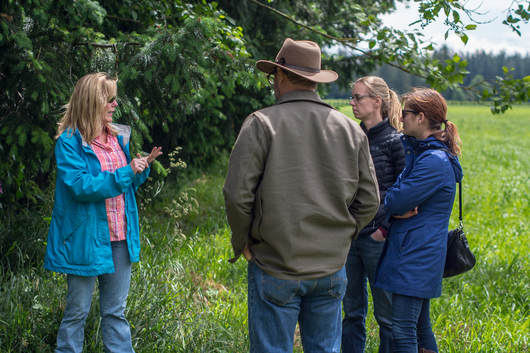 Whatcom County dairy farmer, university professor and agroecologist Karen Steensma (left) explains environmental protection measures she's implemented on her Lynden-area farm. Whatcom County dairy farmer, university professor and agroecologist Karen Steensma (left) explains environmental protection measures she's implemented on her Lynden-area farm. For generations, Whatcom County's family farmers have taken stewardship of the land seriously. In recent years, local family farmers have led hundreds of projects to restore streams, conserve water, protect salmon and so much more. Here are some of the highlights:
And these are just the highlights! There are many more stories that haven't been told, and many family farmers who are doing things big and small each day to protect the environment around them. If you know of more stories we should be sharing with the community, please email Dillon Honcoop at [email protected].
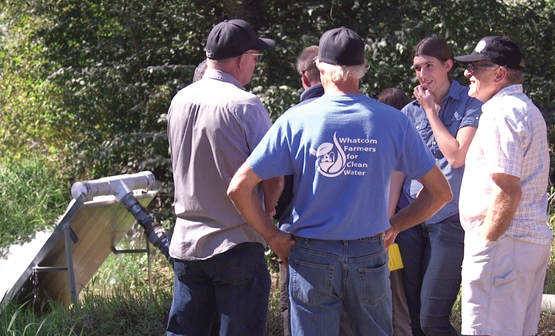 Marty Maberry, longtime leader in the effort to improve conditions on Bertrand Creek, explains the project's benefits while water flows from the custom-designed aerator in the the background. Marty Maberry, longtime leader in the effort to improve conditions on Bertrand Creek, explains the project's benefits while water flows from the custom-designed aerator in the the background. The Bertrand is a relatively small stream that originates in Canada. For many years farmers near the stream had legal rights to withdraw irrigation water directly from the stream. Irrigation was needed at the driest times of the summer at the same time that the natural flows were lowest. The result was a decline in flow to the point of harming fish. In 2004, farmers recognized the problem and formed the Bertrand Watershed Improvement District. This was the first of six farmer-led government entities formed to address water issues. Many farmers were already working hard at conserving water. Marty Maberry, co-owner of Maberry Packing, said the micro-irrigation now used by almost all berry farmers reduced the withdrawals for irrigation by half per acre. But this alone did not solve the problem of low flows. From 2010 to 2016 a number of the farmers were approved to pull their irrigation water from nearby wells instead of the stream. This made a massive difference in stream flows, but at the same time, farmers were working on an innovative idea to increase flow even more: augmentation. This involved pumping water from a well into the creek at the time of lowest flow. They applied for the groundwater permit from the Washington Department of Ecology, and after over two years of delays, were finally granted approval. As the water flowed into the stream, a newly-designed structure aerated the water, refreshing it with a higher oxygen content and new life. Measurements confirmed that the flow had increased all the way to the river. “Farmers understand this is something we need to do,” said Maberry. “Habitat is only one factor affecting fish, but it is one that as farmers we can address. This shows we understand the need for stream flow, for habitat and we respect and support tribal treaty rights.” According to Maberry, the Bertrand augmentation project is just a start. “We see many opportunities to improve habitat with this kind of farmer-led approach,” he said. “But we also look for more support from our government leaders including tribal leaders for help in securing the long delayed water rights that will allow us to continue to farm.” The farming community is eager to keep the Bertrand stream a healthy place for local salmon and trout to thrive, something that may not have been possible had they not taken action.
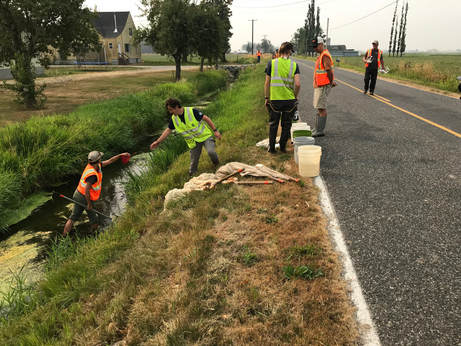 Crews from Whatcom Conservation District, Washington Department of Fish and Wildlife, Washington Department of Ecology, City of Bellingham, City of Lynden and others work to try to save salmon and other aquatic life stranded in Double Ditch Stream. Crews from Whatcom Conservation District, Washington Department of Fish and Wildlife, Washington Department of Ecology, City of Bellingham, City of Lynden and others work to try to save salmon and other aquatic life stranded in Double Ditch Stream. Larry Stap is a fourth generation dairy farmer and co-owner of the popular glass bottled dairy product brand, TwinBrook Creamery, with his son-in-law and daughter. Their farm lies adjacent to the stream along with the Fishtrap creek, hence “twin brook.” When Stap saw the dying fish, he and co-owner Mark Tolsma made an immediate decision: divert their much needed irrigation water into the struggling stream. Well water was pumped into the stream and helped provide the time needed to rescue as many of the remaining fish as possible. It wasn’t the first time Whatcom’s family farmers sacrificed to divert water into streams during the low flow times of late summer. For several years, farmers in the Bertrand Watershed Improvement District worked with state officials to allow them to use well water to pump cold, oxygenated water into the Bertrand creek to support fish habitat. Legal decisions and bureaucratic processes delayed the effort for a couple of years. This action followed the earlier voluntary diversion of water rights. Farmers for years have had the legal right to draw irrigation water directly from the stream, but now understand that during the heat of summer more water is needed in the creek so have been allowed to convert those surface water rights to groundwater rights allowing them to use wells for irrigation. More rights could be converted but unfortunate legal decisions have hindered that process. These are just two of literally hundreds of examples of what Whatcom Family Farmers are calling REAL: Real Environmental Action and Leadership. The public doesn’t automatically think of farmers as environmental activists, and indeed they aren’t in the sense of protesting, suing and lobbying. But they might instead be called “environmental actionists” because of the proactive and positive actions taken to help protect the environment. A few more examples:
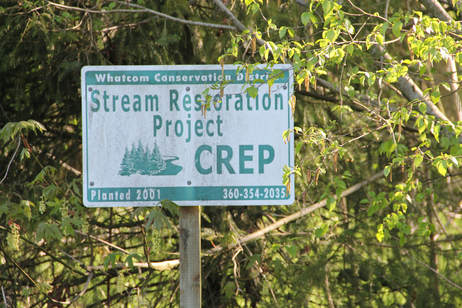
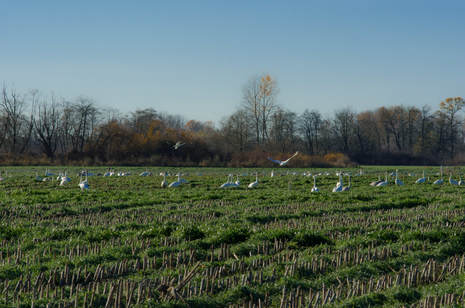
The strict farming regulations combined with literally hundreds of proactive measures taken by farmers to protect the environment are working. Recent monitoring by the Department of Ecology shows that groundwater quality nearest our dairy farms is actually improving. Nitrate levels are restricted by EPA regulations and nitrate above the EPA limit is very common in most areas where farming has long existed. This is because until about the 1970s no one was aware that the heavy use of fertilizer, either organic as in cow manure or commercial fertilizer, meant that excess nitrogen was leaching into groundwater. We now know that it takes 3o to 50 years of improved farm practices to affect nitrate levels in groundwater and the fact that in Whatcom County we are seeing improvement means that what farmers are doing is positively working. Farming has always had an impact on the environment and problems continue as we hear more and more about environmental impacts of farming across the nation and world. Whatcom farmers clearly understand that not all problems have been solved and the potential for contamination remains. That’s one reason why farmers have come together in groups such as the six Watershed Improvement Districts and Whatcom Family Farmers. Together farmers can encourage each other, support positive policy actions and improve public understanding of the REAL environmental leadership farmers provide.
Fishtrap Creek comes to us from our northern neighbors in Canada, crossing the border to wind through both farm fields and the city of Lynden. The stream eventually feeds into the Nooksack River, providing habitat to Chinook, coho, and chum salmon, as well as many other species.
For decades farmers have worked with conservation groups, government agencies, volunteers and students to rebuild healthy fish habitat in Fishtrap Creek. They’ve cleaned up invasive plants and planted native trees to provide stable stream banks that filter water coming to the creek, and even more importantly, provided shade to help cool the water to protect the juvenile salmon growing there. This past year that work continued on a section of the creek that runs through farmland just north of the Lynden city limits. Rader Farms, which grows red raspberries in the field along that section of stream, stepped up to allow conservation workers and volunteers to access the area and contributed the additional land needed to expand the riparian area. The farm also did the hard work of cleaning up the non-native plants that had been choking the stream banks. The team from NSEA guided the project and provided native trees in pots, bark mulch and workers to lead the student volunteers planting trees. Armed with gloves and rubber boots, students from Lynden Christian High School science classes planted hundreds of the new trees. They used bark mulch and plastic tubes to protect the seedlings as they grow up to shade and protect the creek.
After watching agriculture fail in previous places they had lived, the Belisles were drawn to Whatcom County for its vibrant farming community. Along with their family, they planted their first orchard over 20 years ago. The Belisle’s now grow over 25,000 fruit trees and have opened a cafe and distillery! Bellewood Acres is a haven for locals as well as providing a taste of country life to those looking to escape from town for the afternoon. However, it’s the environmental example they set behind the scenes which makes the biggest impact.
When the drainage district came to Dorie for help concerning the grass filled, mud clogged Four Mile creek, she set to work enlisting her fellow farmers to solve the drainage problem. She soon learned just how much her community valued creating sustainable practices to protect their natural resources. Dorie was joined by a team of farmers who were committed to conserving water quality, for the sake of both fish and farming. Not only were the stagnant streams causing flooding of the nearby fields making it difficult to farm safely, but the natural fish habitats were slowly being choked out. The goal of these farmers was to restore Four Mile Creek to a full flowing stream–a place fish could thrive without taking additional land from nearby agriculture. This team set about clearing out the stream and drainage areas. This process allowed new plant growth along the banks which supported the water achieving all required parameters for oxygen, fecal coliform, and temperature. Only two fish from the salmon family were counted in the initial 2003 dredge of the creek. Since then in recent upkeep cleanings, that number has risen to 250. The increased flow of Four Mile also reduced flooding in area, in turn allowing crops to be grown and harvested properly. With the support of government grants, these REAL farmer-environmentalists continue to keep the stream clear and healthy. Farmers are continually learning and changing to be better stewards of the land, passing those lessons down to the next generations. Challenges like the Four Mile creek are being met with passion, and results are beginning to show. Restoring thriving streams is as vital for the farmers as it is for the fish, and projects like this are a prime example of how farming is leading the charge for environmental change. |
AuthorWrite something about yourself. No need to be fancy, just an overview. Archives
November 2023
Categories
All
|
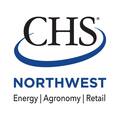




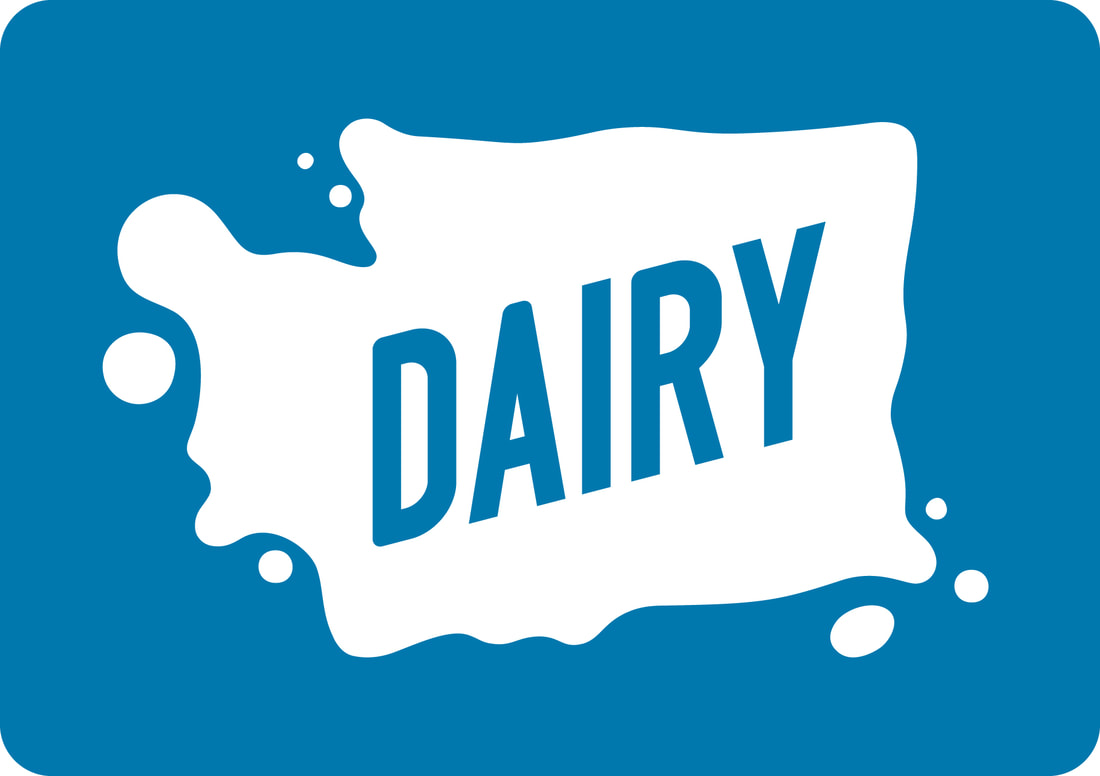


 RSS Feed
RSS Feed